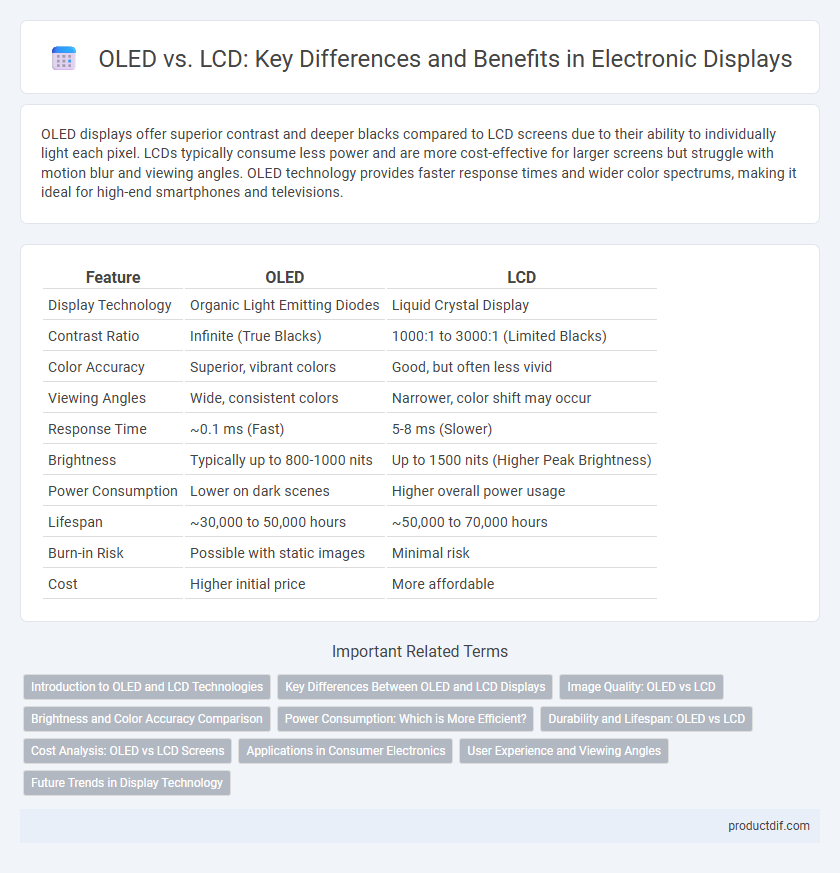OLED displays offer superior contrast and deeper blacks compared to LCD screens due to their ability to individually light each pixel. LCDs typically consume less power and are more cost-effective for larger screens but struggle with motion blur and viewing angles. OLED technology provides faster response times and wider color spectrums, making it ideal for high-end smartphones and televisions.
Table of Comparison
| Feature | OLED | LCD |
|---|---|---|
| Display Technology | Organic Light Emitting Diodes | Liquid Crystal Display |
| Contrast Ratio | Infinite (True Blacks) | 1000:1 to 3000:1 (Limited Blacks) |
| Color Accuracy | Superior, vibrant colors | Good, but often less vivid |
| Viewing Angles | Wide, consistent colors | Narrower, color shift may occur |
| Response Time | ~0.1 ms (Fast) | 5-8 ms (Slower) |
| Brightness | Typically up to 800-1000 nits | Up to 1500 nits (Higher Peak Brightness) |
| Power Consumption | Lower on dark scenes | Higher overall power usage |
| Lifespan | ~30,000 to 50,000 hours | ~50,000 to 70,000 hours |
| Burn-in Risk | Possible with static images | Minimal risk |
| Cost | Higher initial price | More affordable |
Introduction to OLED and LCD Technologies
OLED (Organic Light Emitting Diode) technology uses organic compounds that emit light when an electric current passes through, enabling self-lit pixels with deep blacks and high contrast ratios. LCD (Liquid Crystal Display) technology relies on a backlight shining through liquid crystals and color filters, producing vibrant images but often lacking the perfect black levels possible with OLEDs. Both display types are widely used in electronics, with OLEDs excelling in flexibility and color accuracy, while LCDs remain cost-effective and energy-efficient for many applications.
Key Differences Between OLED and LCD Displays
OLED displays use organic compounds that emit light individually, resulting in true blacks and higher contrast ratios compared to LCDs, which rely on backlighting for image display. LCD screens generally consume more power due to their constant backlight, while OLED panels offer better viewing angles and faster response times because each pixel is independently lit. Durability and lifespan can vary, with OLEDs susceptible to burn-in, whereas LCDs typically offer longer longevity in static image scenarios.
Image Quality: OLED vs LCD
OLED displays deliver superior image quality with deeper blacks and higher contrast ratios due to their self-emissive pixels, which can turn off individually. LCD panels rely on backlighting, resulting in less precise black levels and lower contrast, often causing washed-out colors. OLED technology also provides wider viewing angles and faster response times, enhancing visual clarity and motion sharpness compared to LCDs.
Brightness and Color Accuracy Comparison
OLED displays offer superior color accuracy due to their self-emissive pixels that produce true blacks and vibrant colors, enhancing overall image quality. LCD screens typically achieve higher peak brightness levels, making them more effective in bright environments or direct sunlight. When comparing OLED vs LCD in brightness and color accuracy, OLED excels in color precision and contrast, while LCD maintains an edge in maximum brightness output.
Power Consumption: Which is More Efficient?
OLED displays consume less power when rendering darker images because individual pixels emit light independently and can turn off completely, resulting in significant energy savings compared to LCDs that rely on a constant backlight. LCD screens require a consistently lit backlight that increases power consumption regardless of image content, making them less energy-efficient for predominantly dark or black visuals. In scenarios with bright or white backgrounds, LCDs can sometimes be more efficient, but overall, OLED technology is generally preferred for superior power efficiency.
Durability and Lifespan: OLED vs LCD
OLED displays generally have a shorter lifespan compared to LCDs due to organic material degradation, typically lasting around 30,000 to 50,000 hours. LCD panels, benefiting from inorganic components like LED backlights, usually endure longer, often exceeding 60,000 hours without significant quality loss. Durability-wise, LCDs are more resistant to burn-in and image retention, issues that can affect OLED screens over time.
Cost Analysis: OLED vs LCD Screens
OLED screens typically have higher production costs due to complex manufacturing processes and expensive organic materials, resulting in a premium price for consumers. LCD panels are generally more cost-effective, benefiting from mature, large-scale production techniques and lower material expenses. Despite the initial price gap, OLEDs offer improved energy efficiency and longer lifespan, which can reduce total cost of ownership over time compared to LCDs.
Applications in Consumer Electronics
OLED displays provide superior contrast ratios and faster response times, making them ideal for smartphones, high-end televisions, and wearable devices where vibrant colors and deep blacks enhance user experience. LCD technology remains widely used in budget-friendly monitors, laptops, and large-screen televisions due to its lower manufacturing cost and energy efficiency. Advances in OLED production are expanding its presence in flexible displays and foldable devices, driving innovation in next-generation consumer electronics.
User Experience and Viewing Angles
OLED displays offer superior user experience compared to LCDs by delivering deeper blacks, higher contrast ratios, and more vibrant colors, enhancing overall visual quality. OLED technology provides wider viewing angles, maintaining color accuracy and brightness even when viewed from the side, unlike LCD panels that often suffer from color shifting and reduced clarity. Users benefit from OLED's faster response times and reduced motion blur, making it ideal for dynamic content and immersive multimedia experiences.
Future Trends in Display Technology
OLED technology offers superior contrast ratios, faster response times, and flexible display capabilities, making it a prime candidate for next-generation screens in smartphones, wearables, and foldable devices. LCDs continue to improve with advancements in mini-LED and quantum dot technology, enhancing brightness, color accuracy, and energy efficiency for large-format televisions and monitors. Emerging microLED displays promise to combine the best features of OLED and LCD by delivering high brightness, long lifespan, and energy efficiency, positioning them as a key player in the future of display innovation.
OLED vs LCD Infographic

 productdif.com
productdif.com